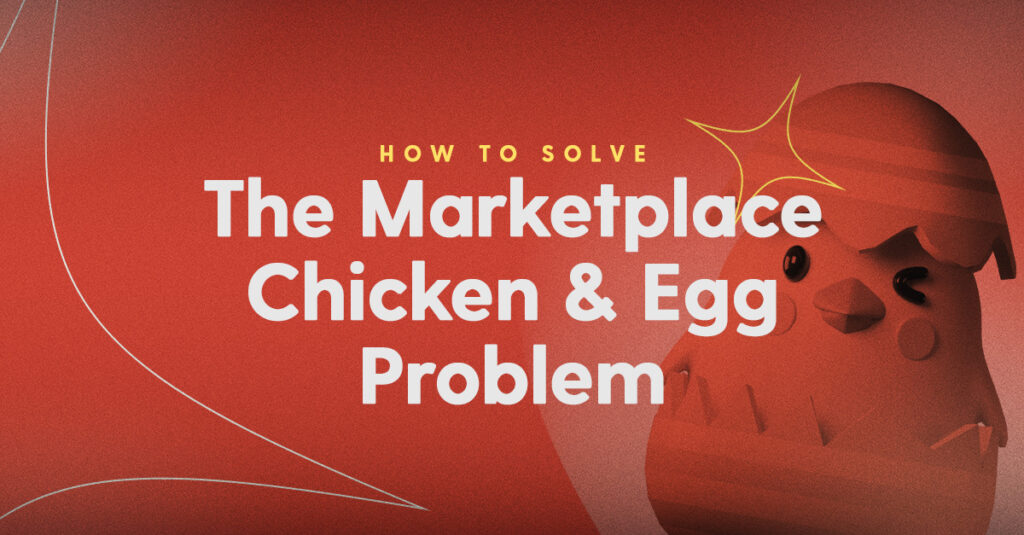
How to solve the chicken and egg problem
How to solve the marketplace chicken and egg problem By James Virgo Table of Contents A two-sided marketplace has a unique problem to solve. It
When building a two-sided marketplace, one essential factor determines your long-term success: generating sustainable marketplace revenue.
Without a clear marketplace monetization strategy, even the best product or service marketplaces will eventually run out of funding and fail.
At Dittofi, after years of experience helping founders build and scale successful multi-vendor marketplaces, we’ve found that the commission-based marketplace model is often the best starting point. Charging a small fee per transaction—whether to the buyer, seller, or both—proves to be the most scalable and effective method for generating revenue in a two-sided marketplace.
However, not every marketplace fits neatly into the commission model. Depending on your users, transaction size, or category complexity, you may need to explore alternative or complementary marketplace business models.
In this definitive guide, we’ll break down the top business models for two-sided marketplaces that actually work in 2025. You’ll learn how each revenue model operates, its benefits, challenges, and real-world examples of marketplaces leveraging them successfully.
Here’s what we’ll cover:
Whether you’re launching a service marketplace, product marketplace, or rental marketplace, understanding these models will help you choose the right approach—and ultimately scale your platform profitably.
Let’s dive in.
The commission-based revenue model remains the most popular and scalable option for two-sided marketplaces in 2025. In this model, the marketplace platform charges a fee for each transaction that occurs between buyers and sellers.
Commission fees can be applied to the buyer, the seller, or split between both parties. These fees can either be a flat rate or a percentage of the total transaction value.
This model is so effective because users—both buyers and sellers—only pay when value is created. Sellers list their products or services without upfront costs, and buyers only pay additional fees once a transaction happens. This removes friction during the onboarding phase and boosts marketplace liquidity.
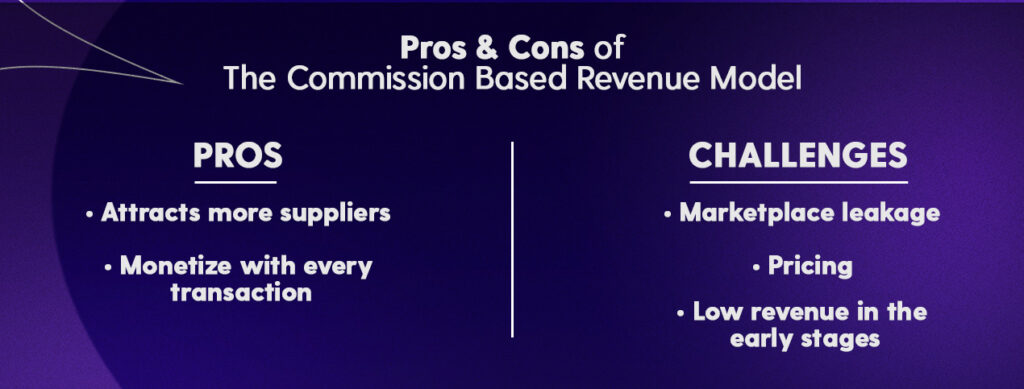
Here are some advantages of the commission based model:
Since sellers only pay after making a sale, it’s easier to recruit high-quality supply to your platform. Sellers view this as low-risk, which helps you grow your marketplace faster.
Every successful booking or sale earns your marketplace a fee, allowing you to scale your marketplace revenue proportionally with platform activity. The more users you attract, the more your revenue naturally grows.
Even with all of these benefits, there are also challenges to overcome with the commission model.
One of the major risks with the commission model is disintermediation (marketplace leakage). Once buyers and sellers connect, they may try to complete future transactions outside of your platform to avoid paying fees. To combat this, you must create strong incentives for users to stay on-platform—such as escrow services, guarantees, dispute resolution, and communication tools.
Setting the correct commission fee is critical. Charging too much will lead to high leakage rates and user dissatisfaction. Charging too little may not generate enough revenue to sustain the business. Some tips to help you determine your commission fee include:
Start low to gain market traction and gradually increase fees as you prove your value.
Benchmark against competing marketplaces in your industry.
Consider the average transaction size: marketplaces selling high-ticket products (e.g., real estate marketplaces) can charge lower percentages, whereas smaller-ticket platforms (e.g., online services or crafts marketplaces) often need higher commissions.
Since revenue is tied to the number of successful transactions, early-stage marketplaces with low transaction volumes will generate minimal revenue. This can make it challenging to sustain operations in the first 12–24 months unless you plan for a longer runway.
Well known companies that use the commission based model effectively include Airbnb, Uber & Upwork.
Airbnb charges a percentage commission on both the host & the guest side of the transaction. The commission percentage will vary, however typically the host is charged 3% & the guest is charged 14.2%. The percentages vary based on predefined criteria. For example, hosts that have strict cancelling policies will be charged more.
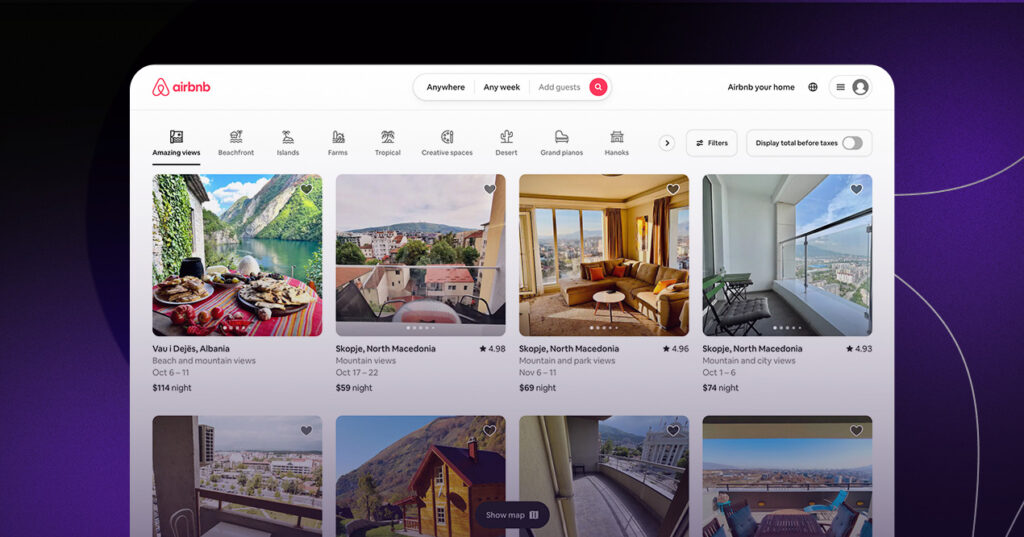
Uber charges 20% – 25% commission of the ride fee. They also charge for add ons such as safe ride fees, booking fees etc.
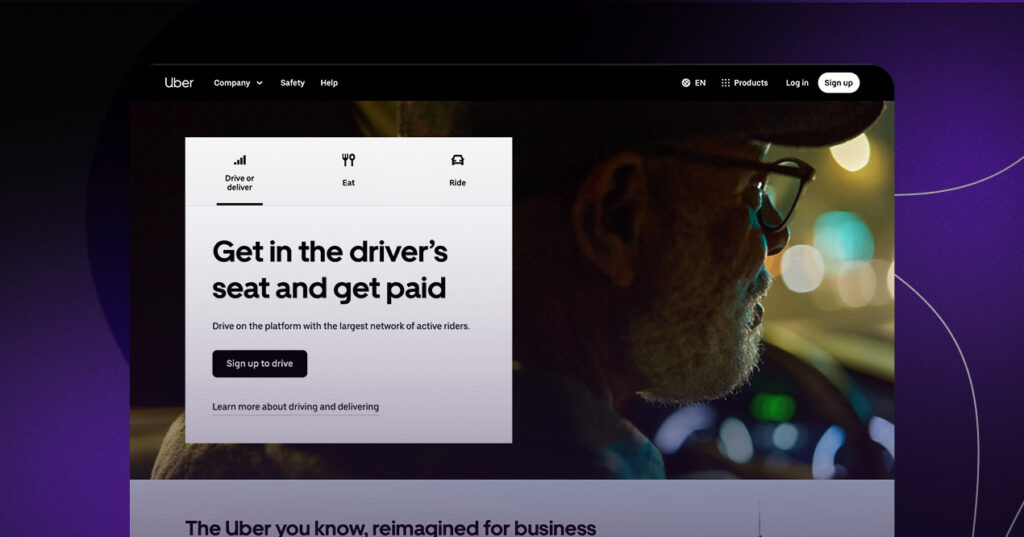
Upwork’s commission model changes regularly. As of September 2023, they were charging a tiered based commission structure of 20% on transactions less than $500, 10% on transactions between $500.01 – $10,000 & 5% on transactions greater than $10.001.
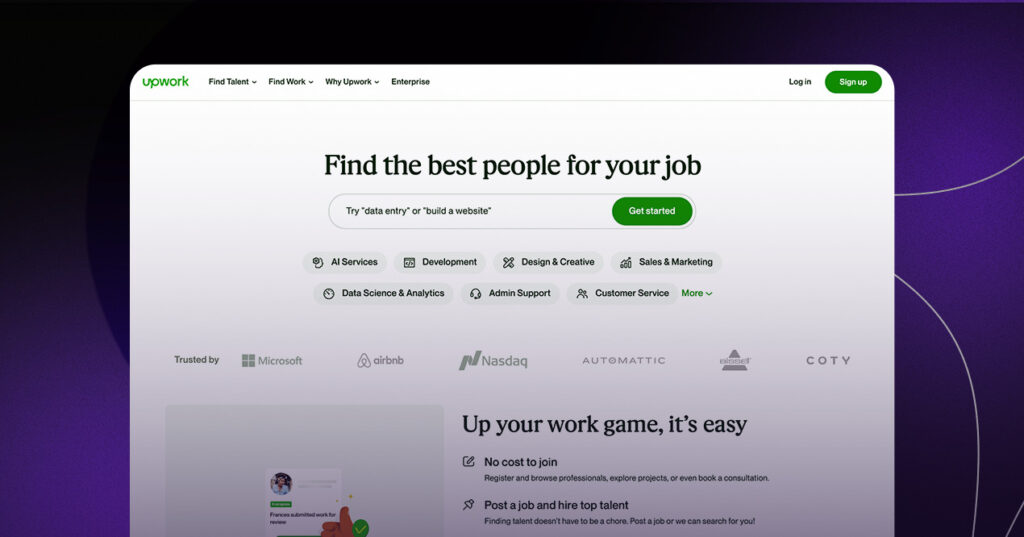
The subscription revenue model for two-sided marketplaces involves charging users a recurring fee—monthly, quarterly, or annually—for access to the platform, its services, or premium features.
The subscription-based marketplace model is especially common when the core value proposition is helping suppliers find new clients or offering access to a curated database of information. In these cases, buyers and sellers usually transact off-platform, and the marketplace generates recurring revenue purely through subscriptions rather than commissions.
Examples of successful subscription marketplaces include dating marketplaces like OkCupid, media streaming marketplaces like Netflix and Spotify, and travel marketplaces like Couchsurfing.
Typically, marketplaces that use the subscription model are better suited for lead generation, content access, or membership-based communities where facilitating the connection is the product, rather than the transaction itself.
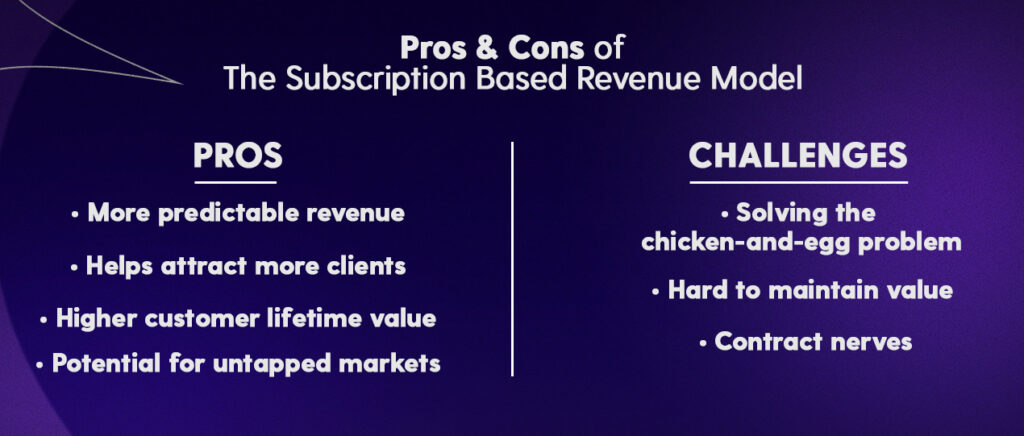
Setting up a subscription model for a two-sided marketplace offers many different benefits; a few of these are listed below.
One of the best things about the subscription based model is that you can easily predict how much revenue is going to be generated over the next few months. This can make it easier to forecast & plan your company finances.
You can offer month-to-month, cancel anytime subscription, or a 12 month subscription or both. 12 month subscriptions make planning your finances even easier & generally, users signing up for a 12 month subscription will be offered a discount to help incentivise this higher level of commitment.
Most subscriptions are relatively cheap compared to one off payments. For example, marketplaces focused on selling to small businesses might charge $500 per month, whereas marketplaces that focus on selling to individuals might charge $20 per month. By making the marketplace affordable, you can attract more clients.
With a commission based marketplace, you are not sure if your customer will come back after the initial purchase. You therefore need to keep investing in customer acquisition strategies in order to get your customer to keep your business running.
In the case of a subscription based model, you can keep regularly earning from the same client. This means that you don’t need to invest as much in customer acquisition to keep your business running.
Some of the most successful subscription based two-sided marketplace disrupt their industries & tap into previously ignored potential.
For example, before Spotify, people had to pay much higher prices to purchase music on iTunes. The cost of buying music as one off transactions racked up very high if you were constantly listening to new music. The subscription model revolutionized this by giving listeners unlimited access to music all for an affordable monthly cost.
Just like Spotify did, you can find new markets by exploring the subscription based business model for your marketplace.
In spite of the many benefits you get from exploring marketplace subscription models, there are also several challenges to be aware of. In this section we take a look at some of these.
In subscription marketplaces, users must continuously perceive value to justify renewing their subscriptions. Marketplaces like Netflix retain users by frequently updating their catalog. Your marketplace must similarly deliver fresh, ongoing value—new connections, updated listings, exclusive content, or premium services.
Subscription based models can make it difficult to attract early adopters. These marketplaces can fall victim to the chicken & egg problem.
In the case of the commission model, we saw that neither the buyer or the seller risked anything by signing up to your platform, since they only pay when they find some value in the marketplace i.e. when a transaction happens.
Conversely, the subscription model forces buyers & sellers to pay in advance of finding any value. Paying in advance may discourage potential users from adopting the platform.
Some ways around this include offering a free trial or discount for early adopters of your product. You may also create different subscription plans such as free, basic & premium & offer different features or rights to each different user group.
It is much harder to sell a yearly subscription than a monthly subscription & it is much harder to sell a monthly subscription than offering riskless free access (as in the case of the commission model). This is because people are generally more nervous about getting into contracts that require regular payments over an extended period of time.
Here are some examples of marketplaces that use a subscription based business model include OkCupid, couch-surfing, Netflix & Spotify.
OkCupid is a dating app that connects people who want to date.
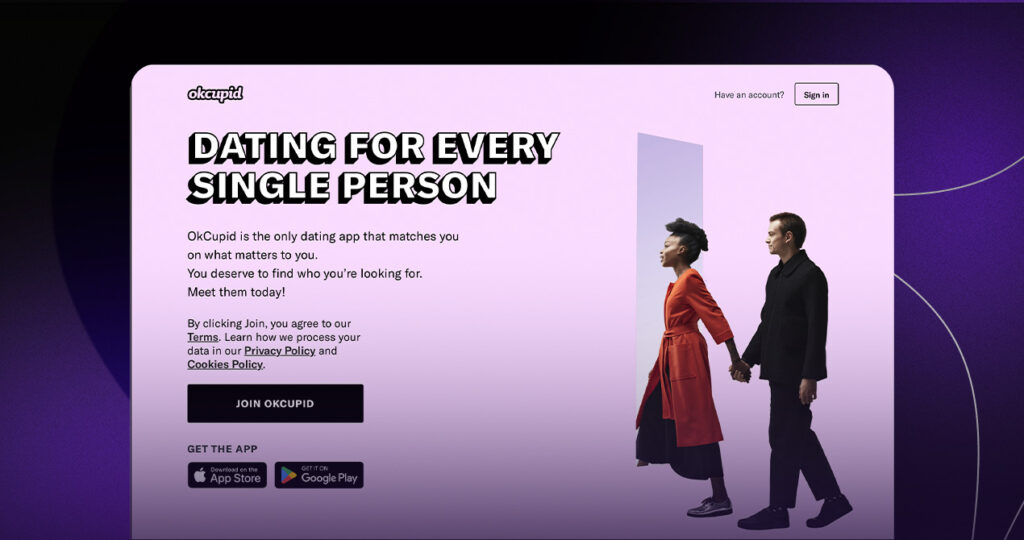
Like other popular dating sites, OkCupid is free to sign up for. OkCupid also offers two paid subscriptions, which are available in three durations. The basic plan comes in at $44.99 for one month, $23.33 for three months, and $14.99 for six months. The premium plan costs $54.99 for one month, $28.33 for three months, and $22.49 for six months.
Couch-surfing is a subscription based marketplace that connects travelers with local people all over the world. Locals can host travelers for short-term stays in their home or interact with other people interested in travel.
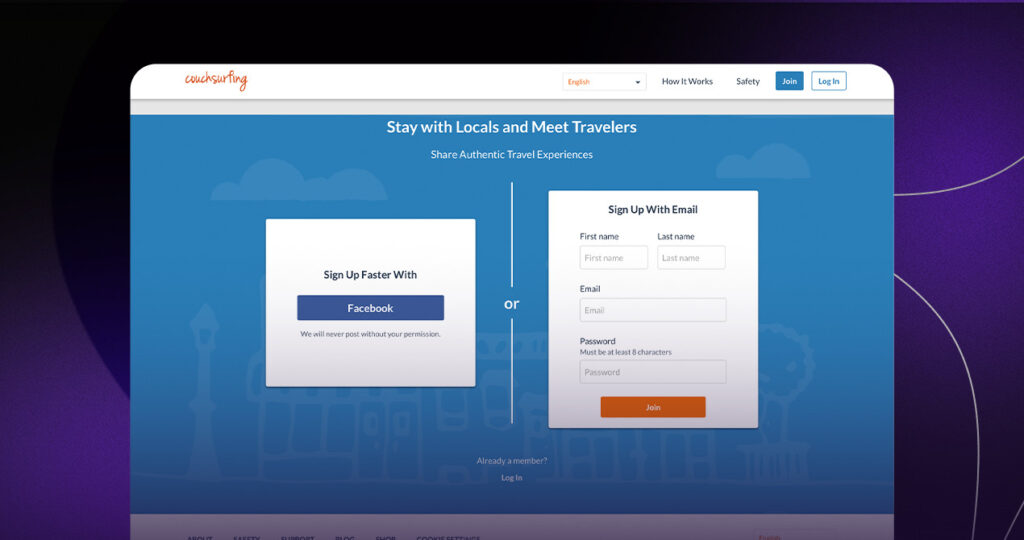
Couch-surfing charges a monthly subscription fee of $2.39. This works out to $28.68 each year. Alternatively, you can take an annual plan which costs only $14.29.
The listing fee marketplace model is a two-sided marketplace business model where vendors are charged a fee every time they create and publish a new listing on the platform. In other words, sellers must pay each time they post a product or service for sale.
Unlike the commission-based marketplace model, where vendors can list items for free and the platform only earns revenue when a transaction occurs, the listing fee model generates revenue upfront—regardless of whether the listing leads to a sale. This approach helps marketplaces monetize all listings, even those that may not be highly popular or immediately successful.
By requiring vendors to pay per listing, this model ensures that only serious sellers post their products or services, often leading to higher-quality marketplace inventory and a more curated user experience.
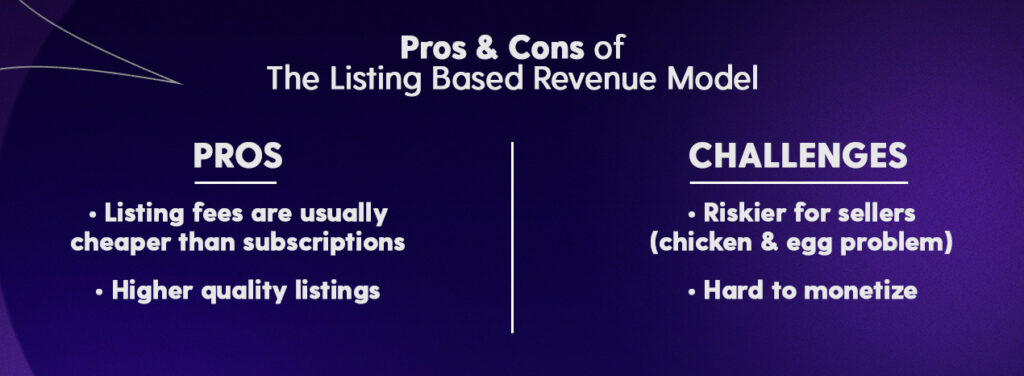
There are several benefits to the listing fee model for marketplaces. These include:
Marketplaces that use the listing fees tend to attract more sellers compared to subscription based marketplaces. This is because marketplace listing fees tend to be cheaper than marketplace subscription fees.
Since it is not free to list, vendors spend more time making their listing high quality, rather than just posting lots of listings & hoping that one of their listings sells.
The listing fee model has several challenges that you will need to overcome.
The listing fee model is riskier for sellers because they need to pay a listing fee before making a sale. This can discourage sellers from using the marketplace.
One way around this is to offer new sellers a fixed number of free listing credits when they sign up, monthly or annually. Another way around this is to offer a free trial period with unlimited listings for the first 14 or 30 days.
Since listing fees are normally very low, it can be difficult for marketplaces to make enough revenue from the listing model to survive. For this reason marketplaces generally only use the listing model as a secondary revenue model.
Two examples of famous marketplaces who use the listing fee revenue model are Craiglist & Etsy.
Craigslist is a marketplace website where users can offer different products & services for sale.
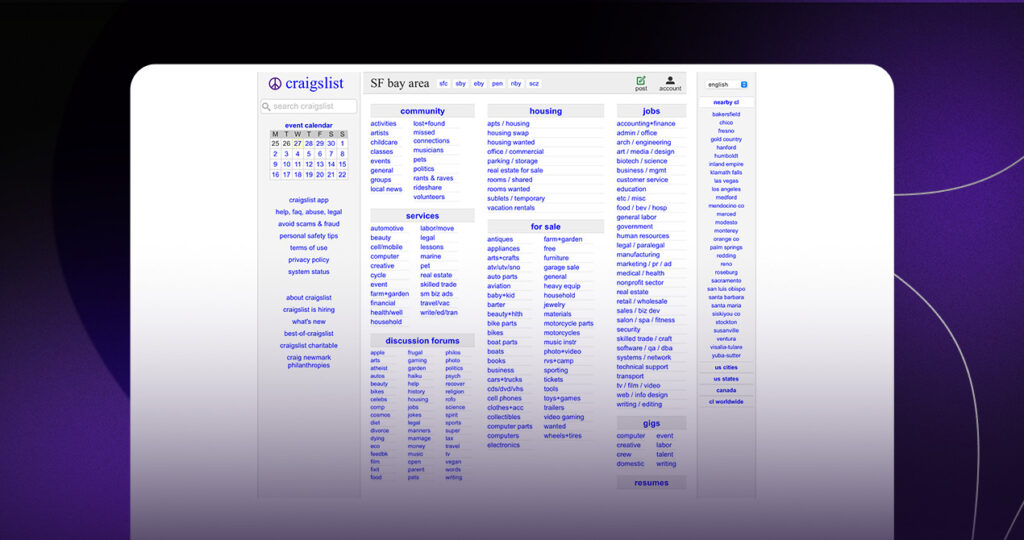
While most of Craigslist’s service is free, it charges $25 to give increased visibility to your listing or ad on the platform. Craigslist charges $25 for job-related ads and several other listing categories. Most of Craigslist’s revenue comes from paid listings where the ads are optimized to appear in certain search results.
Etsy is a global online marketplace, where people come together to make, sell, buy and collect unique & creative items.
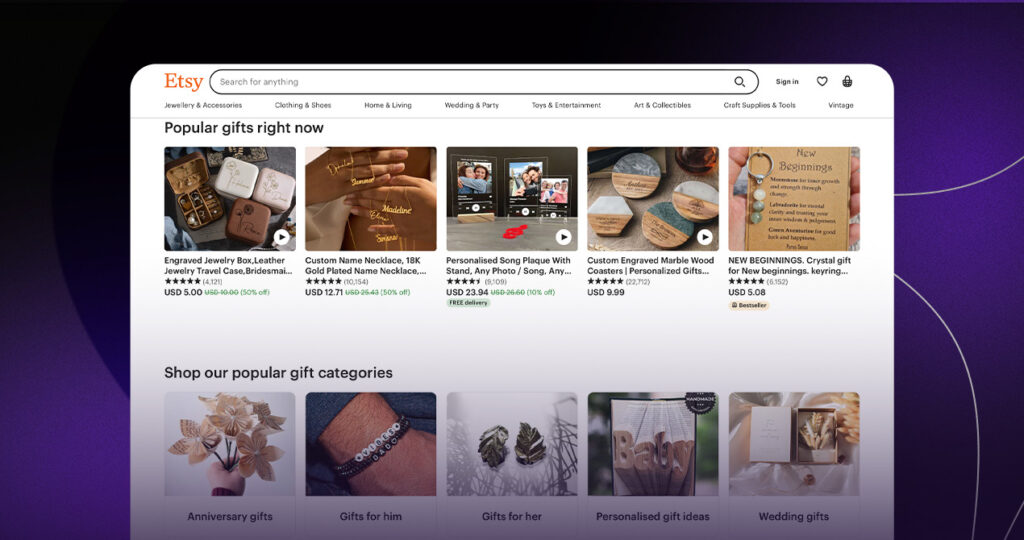
As a marketplace, Etsy makes money primarily by charging a 6.5% commission on items sold via its platform; however, it also has a secondary business model where it charges a $0.20 listing fee for all items that you want to list. This decreased the number of items listed per day but increased the quality of the existing ads. Paying the listing fees allows the user to post this ad for 4 months.
The lead fee marketplace business model—also known as the fees-for-leads model—is a type of commission-based marketplace strategy. In this model, buyers post a request for a product or service on the platform, and the marketplace charges sellers a fee to access or bid for the lead.
Marketplaces using the lead fee model can monetize leads in several ways. Common approaches include charging vendors to view buyer leads, or applying a one-time flat fee for each successful sale or referral that stems from the lead.
Additionally, marketplaces can introduce upsells by offering premium services—such as enhanced customer support, advanced analytics, or lead prioritization—for an extra charge to buyers and sellers.
Some lead-based marketplaces also collaborate with vendors to create special discounted deals, helping incentivize buyers to use the platform and encouraging higher conversion rates.
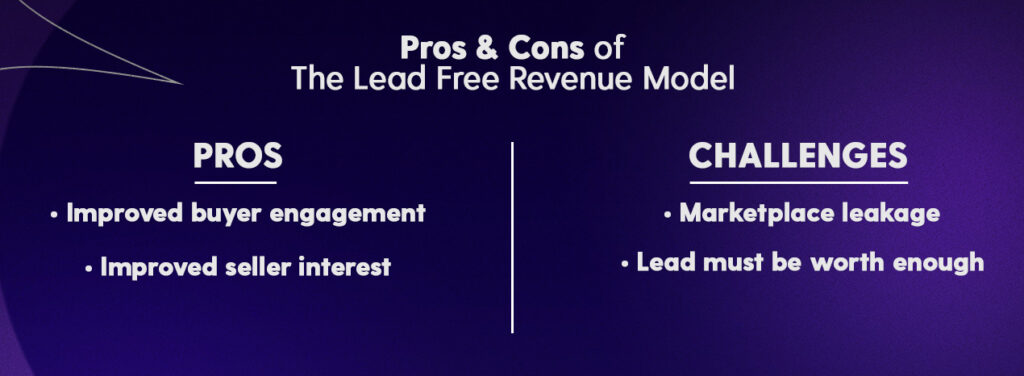
The lead fee model provides a better value proposition than the listing fee model.
As there is no fee for the buyer to list their request, there is no risk to the buyer to list their request for the product or service on the marketplace.
There is a lot of interest for sellers, since buyers come directly to them.
There are two main challenges with the lead fee model: marketplace leakage & that the lead value must be high enough otherwise there is not enough money in the transaction.
If the marketplace charges too much for a lead then this will motivate users to bypass the marketplace after the first transaction has taken place.
If the lead value is not high enough, the marketplace cannot charge enough for the lead to cover the cost of generating the lead.
For instance, let’s assume the marketplace generates a lead for $5000 of labour. A vendor may only be willing to pay $125 for the lead (or 2.5% of the total contract value). This is because the vendor doesn’t necessarily know if they will win the bid & in fact, the vendor knows that they will only win a certain percentage of the leads that they bid on.
Working out how much to charge for a lead is a process of trial & error to work out what is the maximum amount that your vendors are willing to pay.
The most famous company that uses the lead fee model is Thumbtack. Thumbtack is famous for iterating through several business models before landing on the lead fee model that worked for them.
Thumbtack is a marketplace for people to connect with professionals for services across a large range of services.
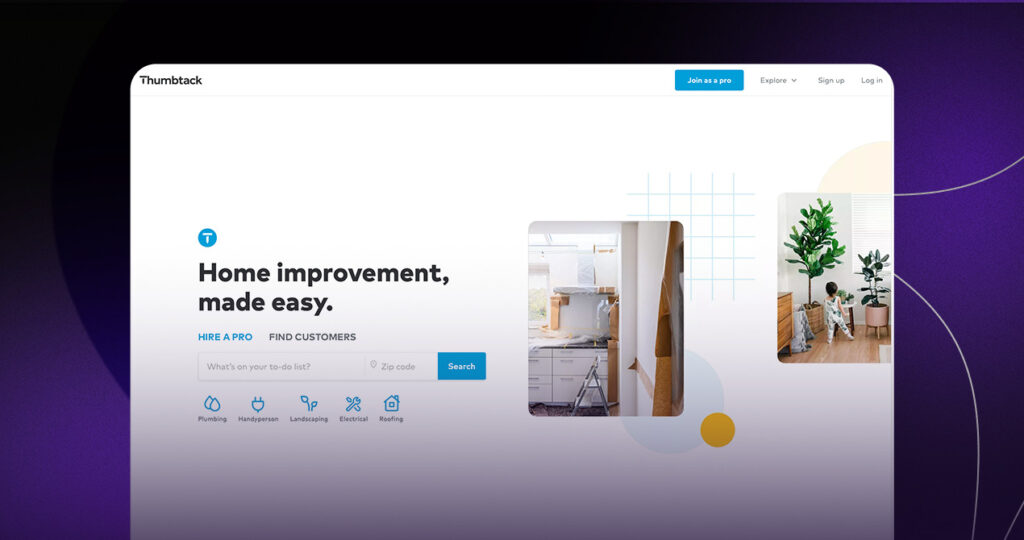
Vendors on Thumbtack buy credits. These credits allow them to send quotes to potential customers. So essentially you’re paying to contact customers. Each lead costs a certain number of credits & the number of credits is determined based on what service the vendor is offering. Credits can be purchased in bulk at discounted rates. All things considered, it will cost between $10 – $100 to get a lead on Thumbtack.
Interestingly, Thumbtack started out as a commission based business model however failed to make it work for them. This was because Thumbtack operates hundreds of categories of service. This made it very difficult to technically & operationally work out who does the job & for how long. As such they were unable to build payments into the platform & as such were unable to take commission.
The freemium marketplace business model operates by offering users access to both free and premium, paid features within the platform. This model can be highly effective for growth but is challenging to execute successfully. To convert free users into paying customers, the marketplace must deliver premium features that are significantly more valuable and compelling than the free offering.
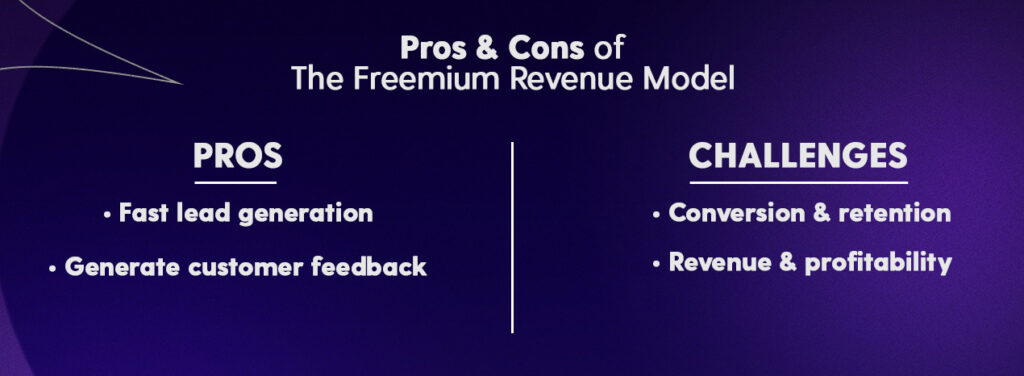
The freemium model has several benefits &, as you will see, there are some who argue that the freemium model will eventually eclipse the commission based model for marketplaces.
A freemium model will allow users to experience the value of your marketplace without paying anything. This is very attractive to both buyers & sellers on your marketplace.
Using a freemium approach marketplaces are often able to build a large user base & gain the trust of these users. The marketplace can then layer in premium features over time that they use to generate revenue.
Another major benefit of using the freemium approach is that the marketplace can collect valuable customer feedback & data. By watching how free users interact with the marketplace, the platform owners can learn about needs, preferences, pain points & behaviours. The marketplace can also solicit feedback through surveys, reviews or ratings.
These types of activities will enable the marketplace to tailor the marketing message, segment the audience & identify the most engaged customers.
In addition to the benefits of the freemium model, there are also challenges & drawbacks that should not be overlooked.
One of the biggest challenges with the freemium model is converting & retaining free users. Not all free users will see the value or the need of upgrading to a premium version &, with less buy in, free users are more likely to churn & switch to a competitor.
To combat this, marketplaces need to carefully design their product so that it creates a clear differentiation between free & premium offerings. Premium features will need to be attractive enough for users to pay for & they must solve enough of your customers’ pain points that you cover the costs of running the free accounts.
If you follow a freemium approach, it is best to monitor key metrics such as customer acquisition costs, customer lifetime value, churn rate & conversion rate.
Another challenge marketplaces face with the freemium approach is profitability scaling & maintaining the quality of the product or service.
The marketplace will have many free tier customers & there is a cost to running these free users. As the number of free users increases, so does the complexity of managing the free tier users. Marketplaces using the freemium model will therefore need to invest in infrastructure, security, support & building innovative premium features.
A great example of the freemium model is the marketplace unsplash.
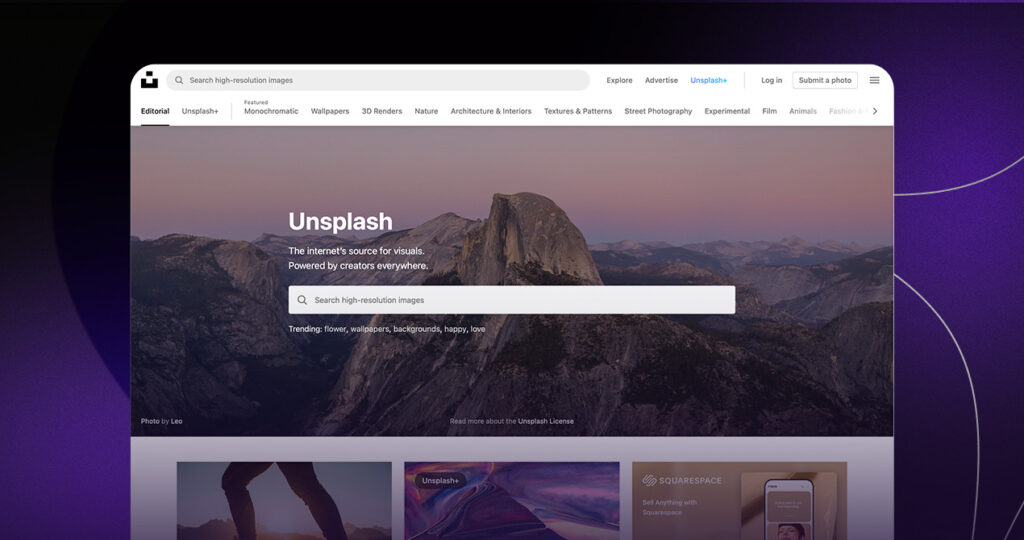
Unsplash is a marketplace for photographs to sell their photos. Photographers upload their work onto Unsplash & then buyers are able to access a subset of the photos for free. If buyers want access to all available stock images, they must pay either a monthly subscription fee or compensate the photographers directly.
The ads and featured listings marketplace model allows vendors to pay for enhanced visibility of their listings. Sellers can purchase advertising or featured listing placements to ensure their products or services appear higher in search results or at the top of specific marketplace categories. By paying for prominence, vendors can significantly increase their exposure and improve their chances of generating sales.
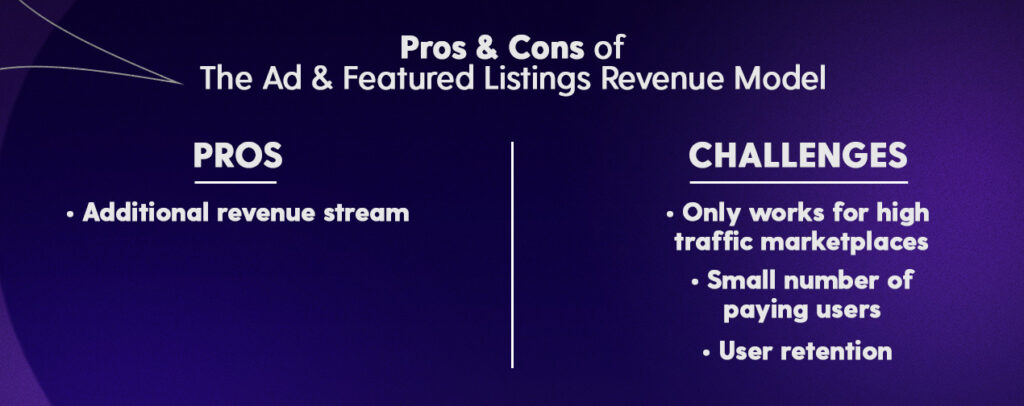
The benefits of using the ads & featured listings model include.
The ads & featured listings model works as a great additional revenue stream for a marketplace. It should not however be your sole revenue stream & you should be very careful not to overload your marketplace with ads.
Even though the ads & featured listings model can be a good revenue generator. There are some challenges to this business model that make it appropriate only as a secondary revenue stream.
The main challenge is driving enough users to the marketplace so that users are willing to pay for the ads. There are many marketplace strategies to drive traffic, most of these either cost money or require a high time investment to set up.
With this business model, the number of paying users will always be massively outnumbered by the number of non paying users. For this reason it is normally only used as a secondary business model in the marketplace.
In addition to the above challenges, you will find that if you have too many ads on your marketplace, this will lead to low user retention. This is because no one likes to be inundated with ads.
Two great examples of marketplaces using the ads & featured listing models effectively are Zillow & Ebay Classified Division.
Zillow is a real estate marketplace that connects realtors, brokers & property managers with their customers. Zillow charges management companies & agents for advertising on their platform.
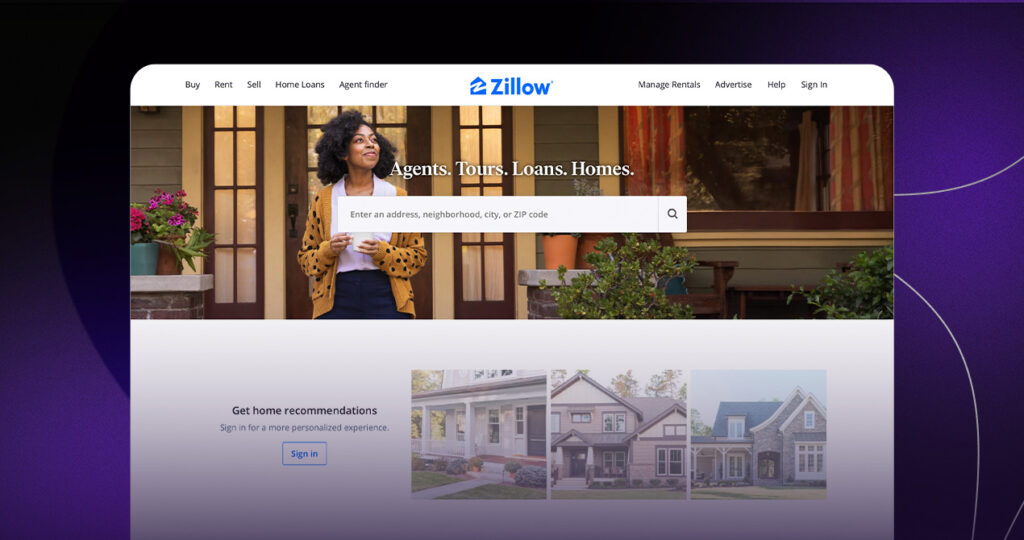
Ebay is an online auction marketplace for people to buy & sell a wide variety of goods & services.
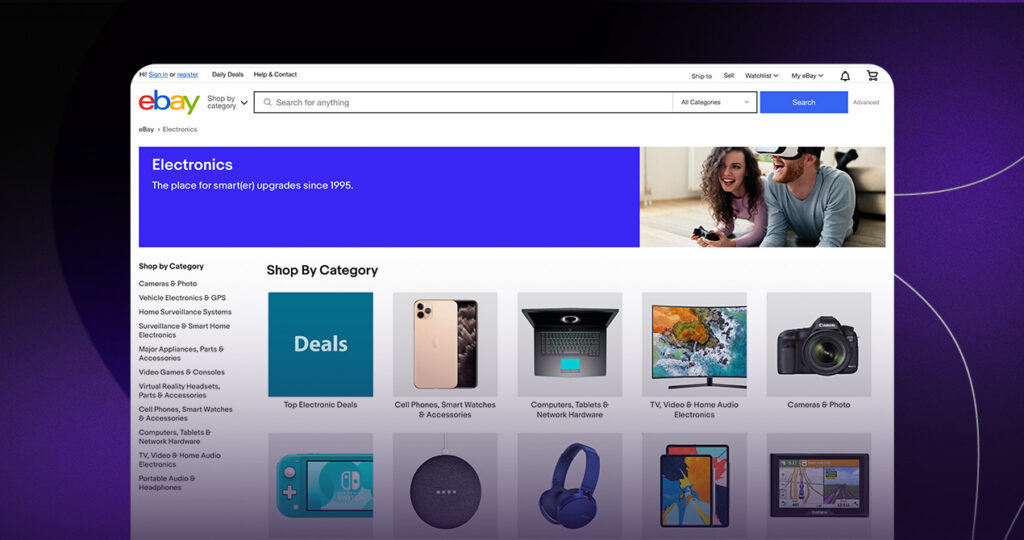
Ebay has a classifieds division where users can list & sell on their platform for free, but users pay a flat fee if they want their offering to be displayed first.
All marketplaces generate data. Depending on the nature of the marketplace and the data it generates, marketplace owners may be able to licence & sell anonymized & aggregated data to third parties or research organisations.
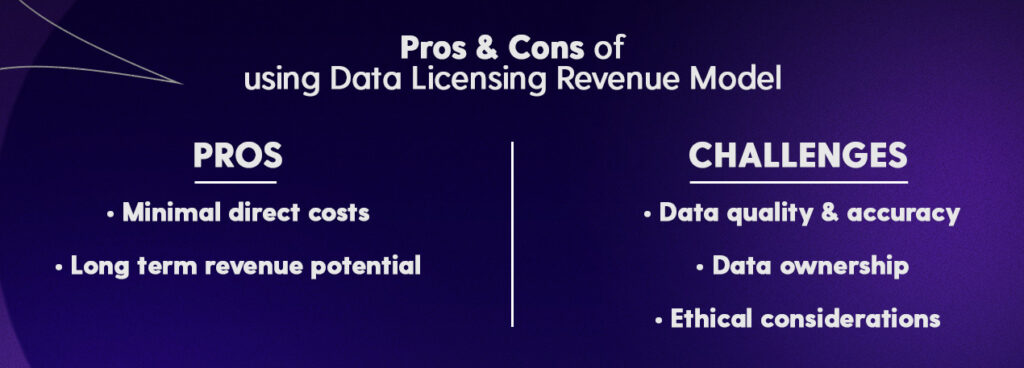
There are several benefits to licensing the data that your marketplace generates for a fee.
Unlike physical products or services, data can often be licensed with minimal direct costs. Once collected and processed, data can be licensed multiple times without incurring significant additional expenses.
High-quality, relevant data can have long-term value, allowing you to generate revenue even after initial collection and processing efforts.
It should come as no surprise that there are high technical challenges when it comes to storing your marketplace’s data securely. However, in addition to the technical security challenges, there are also other challenges to this business model.
Maintaining the quality and accuracy of the data you license is essential. Inaccurate or low-quality data can lead to disputes and damage your reputation.
To do this, you will need to use data normalization & quality assurance techniques. You will also need to make sure that you are storing data in a high quality database.
Clarifying ownership rights and intellectual property rights of the data can be complex, especially if it involves user-generated content or contributions. Before selling any of your users data, it is best to consult with an attorney who specializes in data privacy, intellectual property, and commercial law.
Selling or licensing user data can raise ethical concerns, and transparency about data usage is crucial to maintaining trust with your users.
Many marketplaces who licence data to third parties. For example, Yelp, Twitter, CB Insights, Zillow etc. There are some notable exceptions to this, for example Airbnb who do not allow third parties to access their data unless the third party is guaranteed to substantiate the end-user, or the Airbnb ecosystem.
Let’s take a quick look at how the company Yelp licence their data.
Yelp is a platform for user-generated reviews and business information.
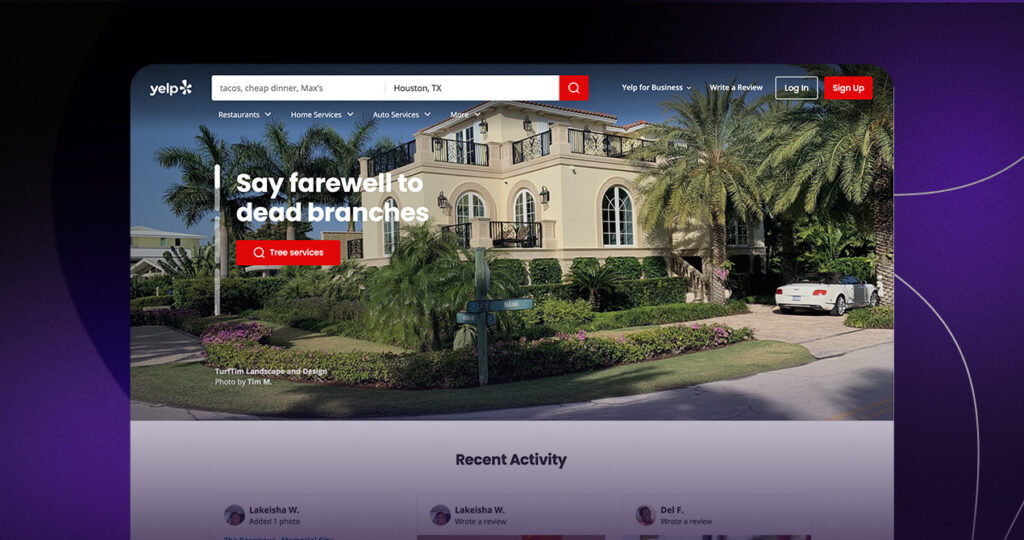
Yelp offers data licensing services through the Yelp Fusion API. Businesses can access Yelp’s local business data to enhance their applications and services.
When selecting a marketplace revenue model, it’s best to start with a single business model that fits your audience and platform goals. Over time, as your two-sided marketplace grows and stabilizes, you can expand by layering in additional revenue streams to increase profitability.
Important: Only add new marketplace revenue models after you’ve successfully validated and optimized one core model. Scaling too early without a proven foundation can hurt both growth and user experience.
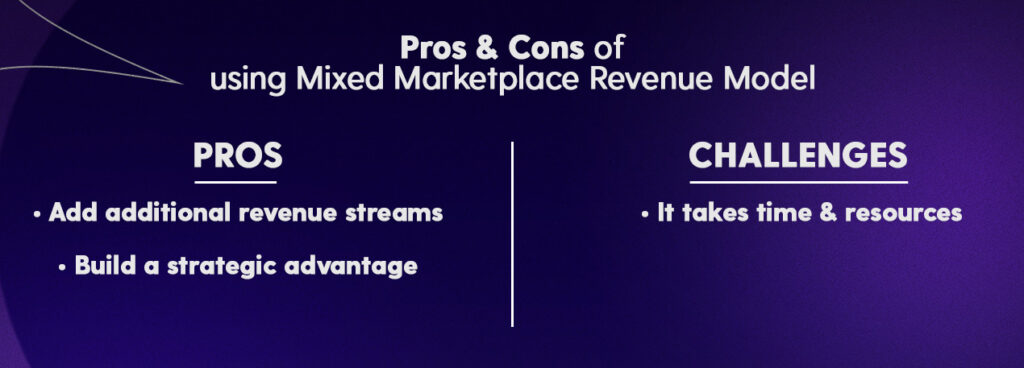
All major marketplaces evolve their business models over time to create a better functioning & more profitable marketplace. Although there are many benefits of the mixed model, the main one is that you can add additional revenue streams.
Of course, the biggest benefit to the mixed model is that you can boost your revenue by finding ways to upsell & cross sell to existing marketplace users.
Imagine that you are operating a commission based model very effectively, however you start to layer in premium features for your power users. You can now charge more for your premium features & maybe even lower your commission to keep your competitors at bay whilst still making more total revenue.
There is one major challenge of the mixed model that you should be aware of.
Although mixed models are great, it takes a lot of time & resources to find even one revenue model that works. Finding multiple revenue models therefore takes a lot of time & resources.
You should not use a mixed model for your business until you’ve first found a marketplace business model that works for you.
Most major marketplaces such as Amazon, Uber, Airbnb, Etsy etc. use a mixed model. Let’s break down how one of these established marketplaces uses the mixed model to both generate more revenue, but also to develop a strong competitive advantage.
We spoke about Etsy above in the section on listing fees. Etsy actually combines three business models together. They use:
Unpacking Etsy’s S1 (and there is a great analysis in Tech Crunch), we see a mixed marketplace business model which is being used to maximize their revenues whilst not losing their users to competitors.
To see why this is the case, let’s use the graph below to break down Etsy’s different revenue streams.
The graph below shows the rapid growth of the premium seller fees which has almost double in the last 2 years, compared to their transaction fees which are growing more steadily.
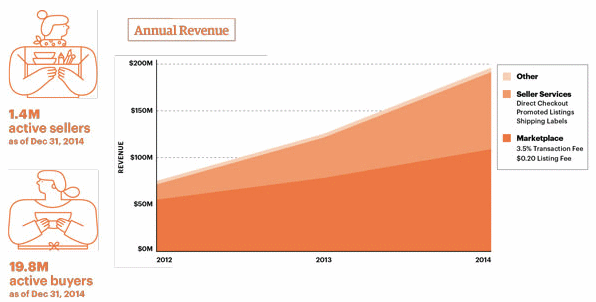
Etsy’s premium seller services represent the fastest-growing revenue stream for the platform. However, these premium features are primarily designed for a small but important segment of users—known as power sellers.
The average Etsy seller isn’t the primary target for these premium services. Most smaller sellers aren’t yet focused on fulfillment efficiency or advanced marketing strategies, which makes premium upgrades less appealing at their scale.
This approach is particularly strategic. By offering premium services only to top sellers, Etsy has been able to increase overall marketplace revenue without raising transaction fees for the majority of sellers.
In essence, Etsy’s mixed marketplace revenue model allows the platform to retain smaller sellers, keep its marketplace attractive to newcomers, and fend off potential competitors—while still maximizing revenue from high-performing sellers.
There are several core marketplace revenue models, but the most popular—and often the most effective—is the commission-based model.
However, there are situations where the commission model doesn’t fit, as we saw with professional services marketplaces like Thumbtack. In such cases, alternative strategies are needed.
Importantly, nearly all successful two-sided marketplaces eventually evolve toward a mixed revenue model. A mixed model combines multiple streams (e.g., commissions, subscriptions, premium features) tailored to different user segments—such as power sellers versus casual users—allowing the platform to maximize revenue and build a strategic advantage over competitors.
Mixed marketplace models are considered the “holy grail” because they enable platforms to scale profitably. But it’s crucial to remember: business models should evolve over time as your marketplace grows and as you gain deeper insights into your users’ behavior.
Start simple. Focus first on finding a sustainable marketplace business model that works, then expand into additional models once you have strong traction.
At Dittofi, we have deep experience helping founders build profitable marketplaces and design scalable business models that drive real growth.
To speak to us about your marketplace, schedule a free 30 minute app consultation with one of our marketplace specialists today.
FAQ
Still have questions?
A marketplace business model is a type of business model where a company acts as an intermediary or platform that connects buyers and sellers in a particular market or industry. In a marketplace, the company does not typically own the products or services being offered; instead, it provides a platform or ecosystem where independent sellers and buyers can interact, transact, and exchange goods or services.
One of the most well-known examples of a marketplace business model is Amazon. Amazon operates as a massive online marketplace that connects millions of buyers and sellers worldwide.
Creating a marketplace business model involves careful planning, strategy, and execution. Some steps involved are: market research, craft a value proposition, choose a business model, choose a tech stack & build your platform, launch your MVP, find users & iterate.
For more information check out our blog on how to build a website like Airbnb.
The average commission rate for a marketplace can vary widely depending on several factors, including the industry, the types of products or services being offered, the level of competition, and the value provided by the marketplace to both buyers and sellers. Commission rates are typically negotiated between the marketplace operator and the sellers.

How to solve the chicken and egg problem
How to solve the marketplace chicken and egg problem By James Virgo Table of Contents A two-sided marketplace has a unique problem to solve. It
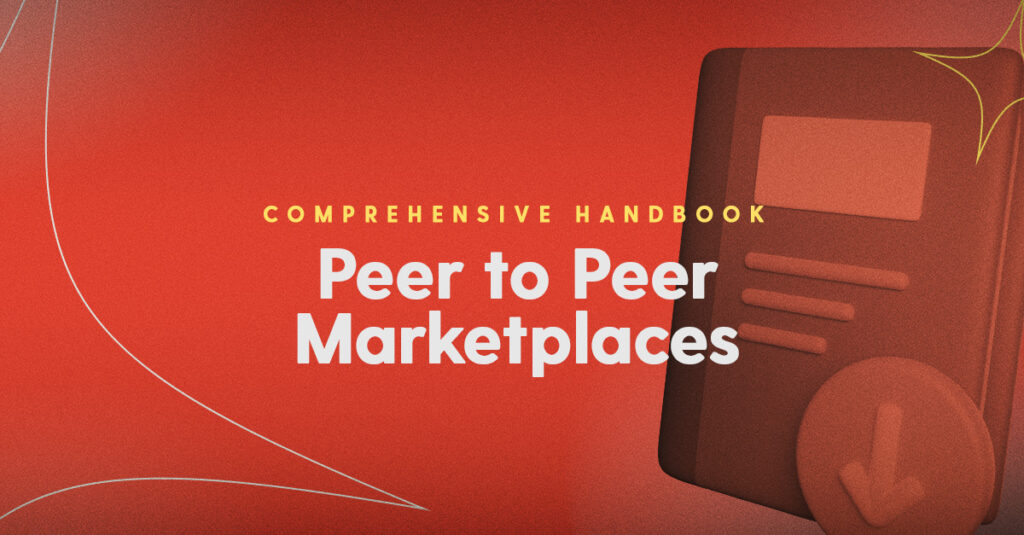
Peer to peer marketplaces: Your comprehensive handbook
Learn – Dittofi Marketplace Insider Series How to Build a Peer to Peer Marketplace (2025 Guide) Welcome to our comprehensive handbook on peer-to-peer marketplaces. From
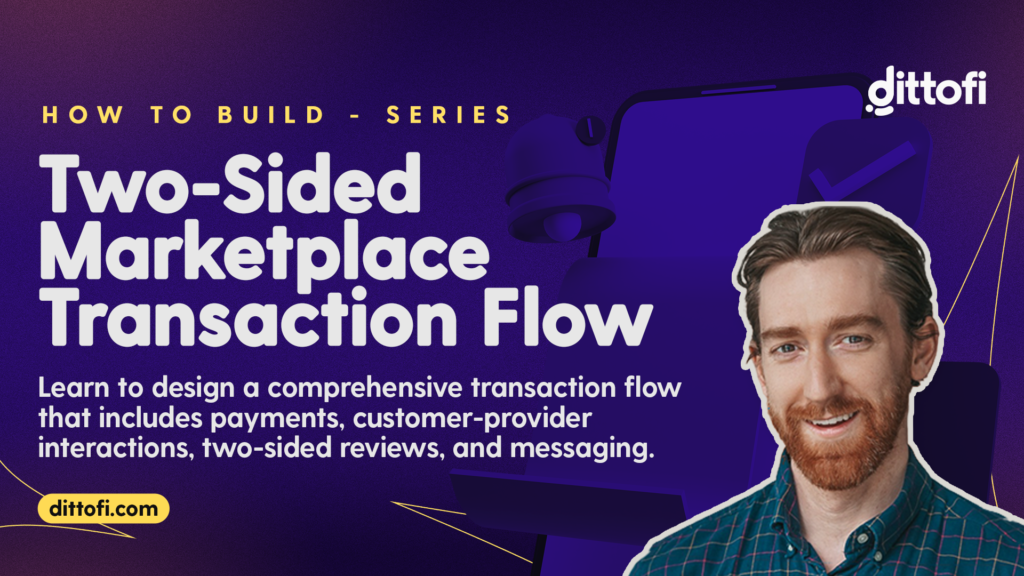
How to design a two-sided marketplace transaction flow
Learn – Dittofi News How to design a two-sided marketplace transaction flow: A Step-by-Step Guide (2025) Etsy has transformed the way people buy and sell

Enter your email below and we will email you a free copy of one of our best guides (28 pages)
⸺ Receive the latest news
Get notified about new articles and events